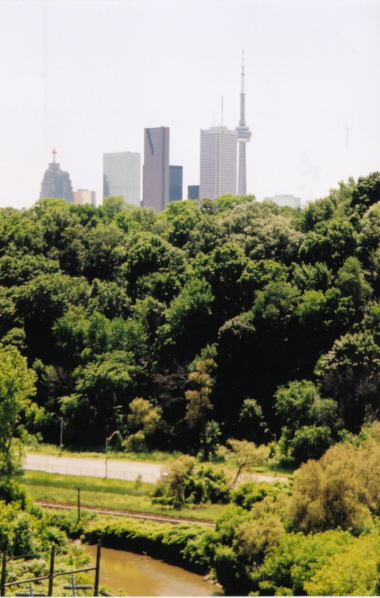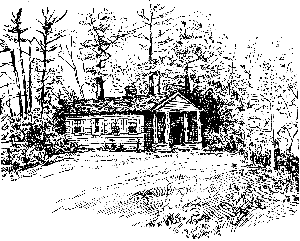

Castle Frank site today

Sketch of Castle Frank
Situated on this tree-covered ridge between Castle Frank Brook and the Don River, Castle Frank had an out standing view of the valley. Wild rice once grew in the river below, attracting geese every fall, and fishing parties would travel up from the lake by canoe to catch salmon. The Simcoes built a summer home on the crest of this ridge, which they named for their son, Francis. Simcoe secured a patent for this land in his young son’s name.
Elizabeth Simcoe tells us in her diary (October 29, 1794) “We went 6 miles by water & landed, climbed up an exceeding steep hill or rather a series of sugar loafed Hills & approved of the highest spot from where we looked down on the tops of large trees. There are large pine plains around it which being without underwood & can ride or walk The height of the situation will secure us from mosquitoes.” In the midst of the original white pine, elm, basswood, and butternut forest, the house was a thirty-by-fifty-foot pine-log structure. Sixteen-foot pillars of peeled pine logs supported porticoes on either end.
Elizabeth used Castle Frank as a summerhouse and country retreat, going up the Don by sleigh in winter or through the woods in summer for picnics and parties. There was a February cariole trip up the river, when Mrs. Simcoe entertained her friends Mrs. Macaulay and Miss Crookshank.
Simcoe returned to England in 1796 due to ill health. Peter Russell used the property after the Simcoe’s departure, and Russell’s friend, John Denison, occupied the house on his arrival at York. Francis never returned to his estate as he was killed in action in Spain in April 1812. Careless fishermen burned Castle Frank to the ground in 1829, and the Simcoe family gradually sold off their property in Upper Canada. John Scadding managed the estate for a while and purchased a portion of the land. In 1844, his son donated some of the property for St. James Cemetery. Much later, Sir Edward Kemp built a second, twenty-four-room Castle Frank, north of the original site. It was demolished in 1962 to make way for the present Rosedale Heights Secondary School. Today, a road, a crescent, and a subway stop perpetuate the name of Castle Frank. (For more about Castle Frank and the Simcoes, see “The Estates of Old Toronto” by Liz Lundell).
